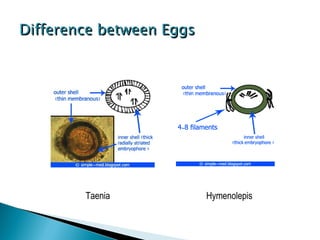Hnana
- 1. -Tapeworms- Dr Kamran Afzal Classified Microbiologist
- 2. Taxonomic Classification of Helminths Fasciolopsis (liver fluke) Schistosoma (not leaf shaped!) Tapeworms Ascaris (roundworm) Trichuris (whipworm) Ancylostoma (hookworm) Necator (hookworm) Enterobius (pinworm or threadworm) Strongyloides Genus – examples Trematodes Non-segmented, usually leaf-shaped, with two suckers but no distinct head They have an alimentary canal and are usually hermaphrodite and leaf shaped Schistosomes are the exception. They are thread-like, and have separate sexes Cestodes Adult tapeworms are found in the intestine of their host They have a head (scolex) with sucking organs, a segmented body but no alimentary canal Each body segment is hermaphrodite Platyhelminthes Flat worms; dorsoventrally flattened, no body cavity and, if present, the alimentary canal is blind ending Nematodes Round worms; appear round in cross section, they have body cavities, a straight alimentary canal and an anus Metazoa Class Phylum Sub kingdom
- 3. Taxonomic Classification of Helminths Fasciolopsis (liver fluke) Schistosoma (not leaf shaped!) Tapeworms Taenia Diphyllobothrium Echinococcus Hymenolepis Ascaris (roundworm) Trichuris (whipworm) Ancylostoma (hookworm) Necator (hookworm) Enterobius (pinworm or threadworm) Strongyloides Genus – examples Trematodes Non-segmented, usually leaf-shaped, with two suckers but no distinct head They have an alimentary canal and are usually hermaphrodite and leaf shaped Schistosomes are the exception. They are thread-like, and have separate sexes Cestodes Adult tapeworms are found in the intestine of their host They have a head (scolex) with sucking organs, a segmented body but no alimentary canal Each body segment is hermaphrodite Platyhelminthes Flat worms; dorsoventrally flattened, no body cavity and, if present, the alimentary canal is blind ending Nematodes Round worms; appear round in cross section, they have body cavities, a straight alimentary canal and an anus Metazoa Class Phylum Sub kingdom
- 5. Tapeworms: The Cestodes They are flat in cross-section Hermaphroditic Live in the intestines Life cycles are complex - can include multiple intermediate hosts No mouth, no digestive system Developed r eproductive structures They have suckers that grasp the host Behind a short neck are repeated parts of the worm - each containing reproductive structures with eggs and sperm - which can be released with the host's feces The pieces give the worm a ribbon-like structure - beneficial for absorbing nutrients from the intestine
- 6. Tapeworms - Morphology The body plan of adult cestodes includes a scolex (looks like the “head”), a neck and strobila that can extend for only a few proglottids or thousands Proglottid: each individual segment Most worms are very long: occupying the entire length of small intestine Scolex Neck Strobila
- 7. Case History A 5-year-old girl The little patient occasionally complained of drowsiness, abdominal pain and anal pruritus, she also endured enuresis and restless nights Anal scotch tape test was negative Physical examination was normal No abnormal readings were found in blood and urine analysis The parasitological examination of concentrated stools revealed …
- 8. -Tapeworms- Hymenolepis nana The ‘Dwarf’ Tapeworm
- 9. Prevalence
- 10. Hymenolepis species Order Cyclophyllidea Family Hymenolepididae 2 known species of Hymenolepis are medically important Hymenolepis nana Hymenolepis diminuta
- 11. Morphology - Adult Consists of Head - Scolex Short neck Strobila contain proglottids Immature, mature, gravid
- 12. The Scolex The scolex is the part of the worm that anchors it to the intestinal epithelium and prevents the worm from passing with the digested food The structure of scolex varies between species of tapeworms Scolex has non-retractable Rostellum armed with double crown of 25-50 hooks
- 13. The Strobila Strobila makes up most of the actual “worm” The strobila consists of a linear series of proglottids Tapeworms are hermaphrodites and each proglottid carries a set of female and male reproductive organs These segments are released and are eliminated with the feces of the host Strobilation: asexual process of forming segments
- 14. Morphology - Egg Eggs are the infective stage Spherical, 70-um-diameter, thick-shell, double membrane Oncosphere contains six central hooklets (hexacanth) with polar filaments These eggs are virtually indistinguishable from other closely related species of tapeworms such as Taenia or Echinococcus
- 15. Difference between Eggs Taenia Hymenolepis
- 16. Epidemiology Hymenolepis nana occurs relatively frequently world wide Usually an infection of children Infections are cleared at adolescence Frequent co-infestation with Ascaris or Giardia Endemic areas include Mediterranean countries, the Middle East, Sub-continent, Australia, New Zealand Patients traveling from these countries to Pakistan Accidental infestation with H. diminuta - the rat tapeworm
- 17. Pathogenesis Transmission: Ingestion of arthropod intermediate host containing cysticercoid larva Pathogenic potential: Nil/very low Damage potential: Nil/very low Reservoir hosts: Rodents, dogs, “normal” definitive host An intermediate host is usually not required Autoinfections occur frequently Cysicercoids develop in the lymphatics of villi of the intermediate host Alternatively infection through cysticercoids in insects that contaminate grains or cereal
- 18. Hymenolepis nana life cycle
- 20. Clinical features Usually none Headache, dizziness Anorexia Abdominal distension and pain Irritability and pruritus Increased intestinal motility Diarrhea
- 21. Diagnosis Microscopy Stool - Demonstration of characteristic eggs Fecal floatation examinations Whole or parts of adult worm Small size of worms - makes observation in stools difficult May cause eosinophilia Antibody detection by Serologic tests IHA, IFA and EIA tests are sensitive tests for detecting antibodies in serum of patients Radiography, Ultrasonography, CT scans
- 22. Treatment Praziquantel A single 25-mg/kg praziquantel dose Niclosamide
- 23. Prevention Children most likely to get infected Proper hand washing Care not to ingest eggs
- 24. Questions Adults inhabit the __________of vertebrate definitive hosts Tapeworms are polyzoic and consist of 3 regions: a. b. c. _______ is the linear series of segments or proglottids Because tapeworms lack a digestive tract, nutrients are absorbed through __________ Tegument protects the tapeworm from host’s __________ Each proglottid is a reproductive individual with both male and female organs, so tapeworms are ________
- 25. Hymenolepis diminuta life cycle

























